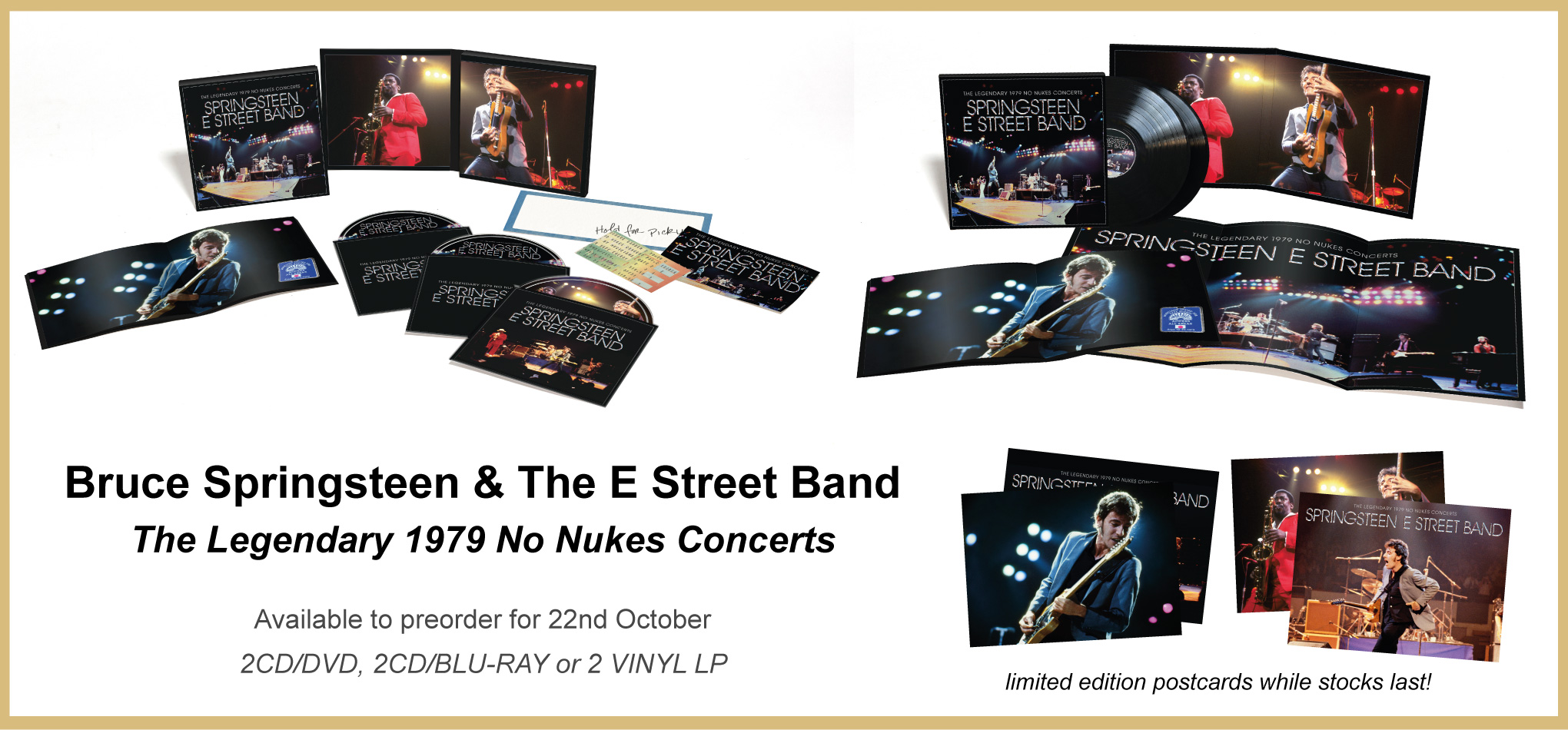 Loading... Please wait...
Loading... Please wait...
THE LEGENDARY 1979 NO NUKES CONCERTS – BRUCE SPRINGSTEEN & THE E STREET BAND Blu-Ray / DVD / CD / Vinyl Review by Dan French
Posted on 18th Nov 2021
In 1979, Bruce Springsteen and the E Street Band were between albums and tours, having completed the 1978 ‘Darkness On The Edge Of Town’ tour and working on studio sessions that would become ‘The River’ in 1980, with the two-year tour that accompanied it. Midway in that period came the opportunity to perform two rare concerts on 21 and 22 September at New York’s Madison Square Garden, as part of a series of benefit events for Musicians United for Safe Energy (MUSE), commonly known as ‘No Nukes’. Although chosen as headliners for two of the four Garden shows, being at the top of multi-artist bills both nights meant their performance duration was limited to about 90 minutes each time. (Later, during another political cause, the Human Rights Now! Tour for Amnesty International in 1988, the headlining E Street set would be similarly distilled, but this was the first time.)
Cinematographer Jon Kilik writes fervently about his memories of the filming experience in the booklet accompanying the release. Crucially, the medium was 16mm film, not videotape, limited to 9 minutes per roll, demanding constant attention – ‘no second chances’, being guided only by the live music as it unfolded. The energy of Bruce and the band ‘was almost impossible to keep up with’, and so technical limitations meant that not all the action could be captured. Although some footage appeared in the original 1980 ‘No Nukes’ movie, this is the first time that the best of both E Street shows has been combined – over 40 years later – by film-maker Thom Zimny to create the effect of a single full event. One clue to spotting the two different nights is changes in clothing, particularly the colour of Clarence Clemons’s stage wear, and a switch of shirts by Bruce. Significantly, although the separate shows were previously issued in audio form as part of the Nugs live archive series (now withdrawn), Bob Clearmountain has produced superlative audio mixes for the various formats of this release, enabling the sound to jump out as much as the images.
Shot from multiple angles including from the very front of the stage between Bruce and Clarence, the well-balanced editing effect is mesmerising, often placing the viewer right in the action – and action is the word, there’s nothing static here. What a joy to see Clarence Clemons and Danny Federici gracing the stage in their prime of life, and to ‘stand’ beside Clarence as he plays the ‘Jungleland’ solo. The band are so tight you’d think they were fresh from months on the road, rather than only getting a studio tan.
Avoiding direct comment on the nuclear issue, Bruce dedicates ‘The Promised Land’ to some key musicians behind MUSE. The setlist is a natural (if condensed) evolution from a typical 1978 concert, with the notable inclusion of two songs destined to herald ‘The River’, the title track (premiered at these shows) and the already familiar ‘Sherry Darling’. Before the former, Bruce accepts an early birthday cake (saying ‘Don’t remind me!’) before flinging it back into the audience, adding ‘Send me the laundry bill!’ and observing he thought the cake hit Stevie’s mother. Another notorious incident reflecting his unease about ageing has been prudently edited out – when Bruce pulled his ex-girlfriend Lynn Goldsmith out of the crowd for allegedly taking photographs without his permission. ‘I’m officially over the hill – I can’t trust myself any more’ prefaces the raucous frat-rock workout of ‘Sherry Darling’, all defiantly youthful exuberance. There’s an audible roar from the folks behind the stage when Bruce signals to the band to swing round and play in that direction at the end of the song. By the time he dedicates ‘Thunder Road’ to some fans who brought gifts to his hotel, his concern about not being ‘that young anymore – that’s all right with me’ has turned to unbridled glee.
Special guests and fellow MUSE musicians were Jackson Browne, Tom Petty and Rosemary Butler, adding extra vocals (and big grins) to a spirited cover of Maurice Williams’ ‘Stay’. Petty only appeared on the 22 September performance, also the same night ‘Quarter To Three’ was played. The final inclusion ‘Rave On’, shown during the credits, took its place as the last number from 21 September, racing at breakneck speed to a close.
Mostly shot in the dark with minimal stage lighting, the house lights come up for the final songs, enabling the cameras to highlight some shots of the audience, clearly sharing the delight onstage. Without big screens or fancy effects, the cavernous arena is made to feel like a party in a club – one of Bruce’s magic tricks.
When people think of Bruce Springsteen and the E Street Band live, they think in terms of the three-or-more-hour concerts for which they are rightly famed. This document shows all the energy and passion of a three-hour show concentrated and packed into just 90 minutes, which is guaranteed to fly by as you watch, giving you time to watch it all over again. Encore!



